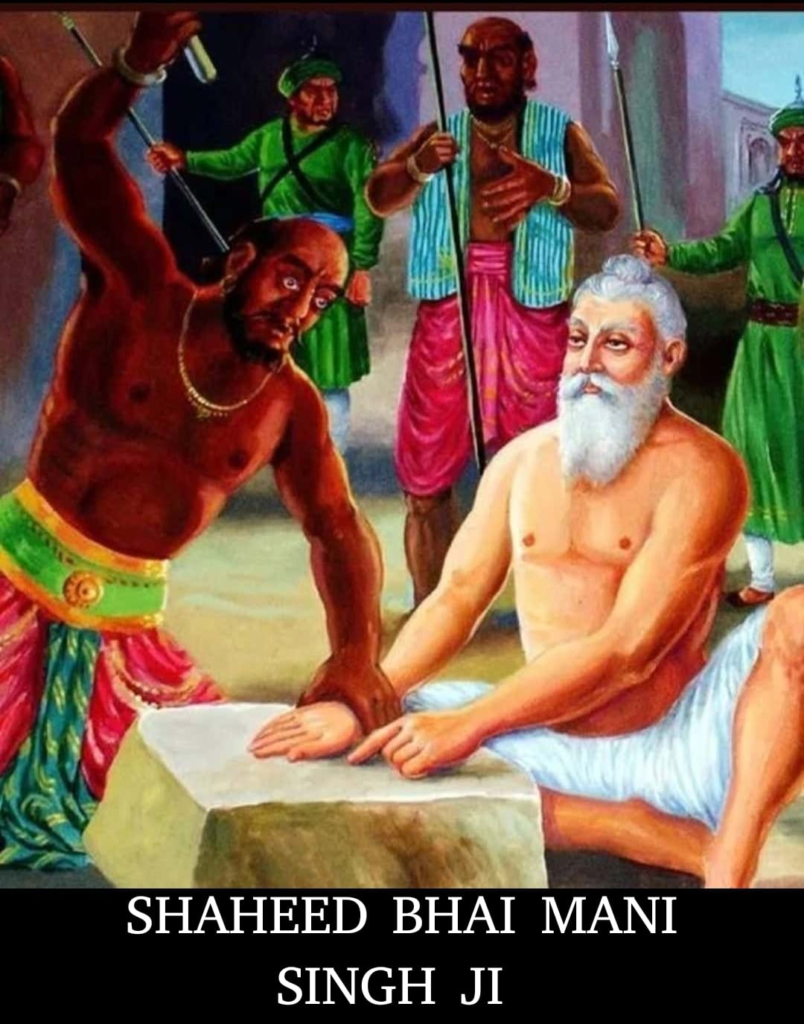Shaheed Bhai Mani Singh Ji: A Beacon of Sacrifice and Inspiration
Bhai Mani Singh Ji, a divine soul and a revered martyr of the Sikh faith, was born on March 10, 1644 CE, in the village of Longowal, Sangrur district, Punjab. According to some scholars, his birthplace is also considered to be the village of Alipur, Muzaffarnagar district (now in Pakistan). His father’s name was Bhai Mai Das, and his mother’s name was Madhri Bai (Sito).
Baptism and Service to the Guru
On the historic Baisakhi day of April 1699, Bhai Mani Singh Ji partook in the Amrit Sanchar ceremony (baptism through the Khanda-Bata) and became a beloved Sikh of Guru Gobind Singh Ji. Throughout his life, he participated in numerous battles and rendered significant services to the Guru’s household. Due to his dedication and service, he was appointed to the esteemed position of Diwan of the Guru’s court. During the battle of Anandpur Sahib, when the Guru’s family was separated at the banks of the Sirsa River, Bhai Mani Singh Ji safely escorted Mata Sundar Kaur Ji and Mata Sahib Kaur Ji to Delhi.
Literary and Administrative Contributions
Bhai Mani Singh Ji played a pivotal role as a scribe in the rewriting of the sacred Bir of Sri Guru Granth Sahib Ji. He also served as the third Head Granthi of Sri Harmandir Sahib, contributing significantly to the management of the holy shrine and the Sikh congregation.
Efforts to Unite the Sikh Panth
Following the martyrdom of Baba Banda Singh Bahadur, the Sikh Panth was divided into two factions—Tatt Khalsa and Bandai Khalsa. Bhai Mani Singh Ji, with his wisdom and unwavering dedication, made significant efforts to unite these factions, fostering harmony within the Sikh community.
The Priceless Tale of Martyrdom
On the occasion of Diwali, Bhai Mani Singh Ji sought permission from the Mughal governor Zakariya Khan to hold the Sarbat Khalsa gathering and the associated fair. He agreed to pay a tax of ten thousand rupees for the event. However, Zakariya Khan’s treachery led to an attack on the gathered Sikhs, resulting in the martyrdom of many. When Bhai Mani Singh Ji protested, he was arrested and faced the ultimatum of either converting to Islam or embracing martyrdom. Unyielding in his faith, Bhai Mani Singh Ji chose martyrdom and was brutally dismembered limb by limb at Nakhas Chowk, Lahore, on June 14, 1734.
The Family’s Sacrifice and Literary Legacy
Bhai Mani Singh Ji’s family exemplified unparalleled devotion. Among his twelve brothers, eleven embraced martyrdom for the Sikh faith. Of his ten sons, seven also attained martyrdom. His grandfather, Bhai Ballu Rai Ji, sacrificed his life fighting alongside Guru Hargobind Sahib Ji.
Bhai Mani Singh Ji was not only a valiant warrior but also an accomplished scholar. His literary contributions include the compositions of Gyan Ratnavali, Bhagat Ratnavali, and Guru Vilas Patshahi Chhevin, which remain invaluable treasures of Sikh literature.
Bhai Mani Singh Ji’s life is a testament to sacrifice, devotion, and courage. His martyrdom serves as an eternal source of inspiration, teaching us the importance of unwavering commitment to truth and righteousness.
